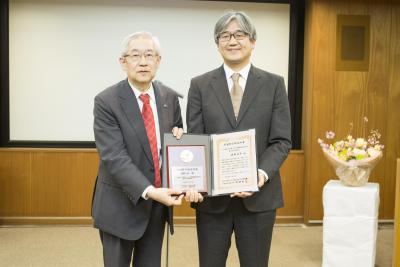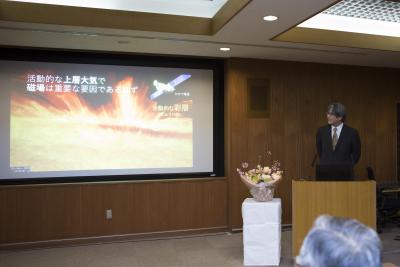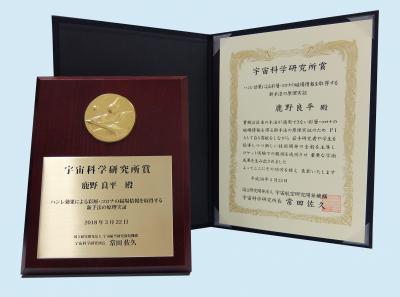Associate professor Ryouhei Kano has received the ISAS Award!
Associate professor Ryouhei Kano of the SOLAR-C project office has received the Fourth ISAS Award. He was awarded for the success of verifying the principle to obtain the information on the magnetic fields of the solar chromosphere to the corona by the Hanle effect. It was evaluated that the success of the sounding rocket experiment CLASP opened the way to measuring the magnetic fields in solar upper atmosphere. The ISAS Awards are given to those who belong to organizations outside JAXA and made remarkable achievements and contributions being the key for the success in the space science and exploration projects.
The awarding ceremony was held in ISAS/JAXA on March 22 and Associate professor Kano gave a short lecture on the result for which he was awarded.
Associate professor Ryouhei Kano says:
The result from the CLASP project for which I was awarded was not achieved by me alone. I think that the award was given to all the members of the CLASP project. I am very happy that the result was evaluated by ISAS/JAXA.
The reflight experiment CLASP2 is planned and now we are proceeding with the preparation well. Obtaining the further results, I will continue to contribute to solar observations using spacecraft, especially in polarimetry.
About the result for which the award was given:
Above the solar surface in 6,000 K, the solar upper atmosphere "corona" is heated up to more than 1 million K. The magnetic field is thought to play an important role in the heating mechanism. For revealing this mechanism, the information on magnetic fields in the upper atmosphere is essential in addition to that on the solar surface as measured by Hinode. However, because magnetic fields generally becomes weaker in higher atmosphere, it is difficult to measure the magnetic fields in the upper atmosphere by the conventional method using only the polarization from the "Zeeman effect". Therefore, Associate professor Kano and the CLASP project members developed a rocket-born instrument to observe the polarization in a UV line, and then tried to obtain the information of the magnetic fields in the chromosphere and the transition region, which are the solar atmosphere between the solar surface (photosphere) and the corona, by an alternative method using the "Hanle effect". The instrument was launched with NASA's sounding rocket, and they successfully obtained the information on the magnetic fields. Now they are preparing for the reflight experiment CLASP2 by improving the returned CLASP instrument.
Regarding the use of images and movies on the page concerned, please visit the page here. The credits of images and movies on this page are “NAOJ/JAXA” unless explicitly stated to the contrary. Regarding images and movies on this page the credits of which are “NAOJ/JAXA”, "NAOJ/JAXA/MSU", or “NAOJ, JAXA, NASA/MSFC”, terms of use for Copyrighted Works owned by NAOJ can be applied. In using the images and movies, the credits should be given.



